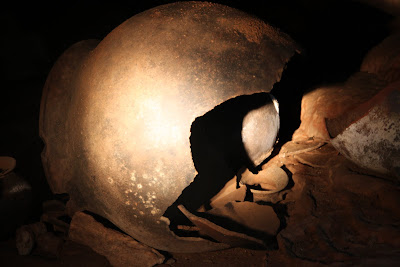The most adventurous part of the trip was probably here in Belize, roughly an hour’s drive out of San Ignacio. After a 40 minute hike through thick, lush, tropical jungle and thrice crossing the Mopan River, we had reached the mouth of the Actun Tunichil Muknal (ATM) Cave, known as a living museum of Mayan relics. We stored our cameras in waterproof bags (which, unfortunately meant I couldn’t photograph the stunning green waters we plunged into as we swam our way into the cave) and strapped on our mining helmets. While some guides allowed other explorers to strip down to their bathing suits, ours was extremely particular about observing the ancient traditions of the Mayans, and at the very least, ensuring we showed the respect due to such a holy place, highly concentrated with thousands of years of built up potent energy garnered through faith, chants, and rituals. We were requested to remain clothed with our swimming suits underneath, and upon entering the chamber of rituals, further requested to remove our shoes and vigilantly navigate around the intentionally strategically placed remnants of the ancient Mayan people.
 Pottery shards from Mayan rituals
Pottery shards from Mayan rituals
I fully understood why this was referred to as an Indiana Jones activity upon reaching the mouth of the cave. Caving requires swimming, hiking, and climbing through body deep waterways, jagged crevices we could barely squeeze our bodies through, and massive caves several meters high, with only our head lamps showing the way forward. Gazing above and around, we gasped with awe at the natural limestone formations protruding from the walls, ceilings, and floors of the cave in the form of stalagmites, stalactites, and pillars formed over thousands of years once these two ends met. Jellyfish-like and other configurations hung over us in hues of whites, creams, corals, and reds, glimmering at the touch of light from our torches. The cave is 3 miles deep, however the Mayans took their rituals further into the cave only a few hundred meters every 300-500 years before finally reaching the ceremonial room to conducts their rituals over a 1,400 year span. The ceremonial hall contains the remains of altars, spirit catchers, and other ritual instruments left in their original, very strategic positions based on astrology and formations configured by auspicious numbers, the most significant being 3, 5, 7, 9, and 13. Skeletal remains of the shaman elders and sacrificed young people, most likely for rain in such a freshwater-sparse region, are also strategically scattered throughout the hall, the most famous being that of an ostensible young, princess of a Mayan kingdom, known as the Crystal Maiden, who was believed to have been killed by a mortar stone to the back of the head.
From San Igancio, we boarded a chicken or local bus for the 3 hour drive to Belize City, one large shanty town rife with poverty and criminal activity. From here, we caught a 45 minute water taxi to Caye Caulker, a limestone coral island measuring 5 by 1 miles. By this point in the trip, a virus turned sinus infection was taking its toll, and while the rest of the group went sailing and snorkeling along the Belize Barrier Reef, I tried to enjoy brunch on the beach and catch up with emails before crawling back into bed for some much needed rest. For the remaining 2 nights, we did, however, enjoy some of the juiciest lobster and fresh fish dinners. It was time to get ready for the next and final stop, Mexico!


















No comments:
Post a Comment